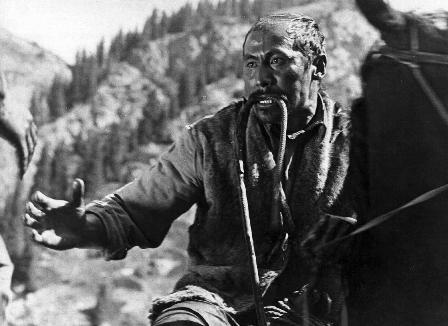Red Westerns – A Short History
Red Westerns – A Short History
The Thirteen, The Elusive Avengers, At Home Among Strangers, a Stranger at Home, Lemonade Joe, Chingachgook: The Great Snake… these films were beloved and highly appreciated in the Soviet Union. Millions of people went to see them again and again for the pleasure of watching the exciting adventures of their cinema heroes. Red Westerns were not only in huge favour amongst audiences, some of them were also great masterpieces. (From: Red Westerns, Sergey Lavrentyev, 2009)
1920s: The Beginning Red Westerns originated during the first years of the Union of Soviet Socialist Republics (the USSR lasted from 1922 to 1991). At that time, a great many American Westerns were being distributed in the Soviet Union. Lev Kuleshov, one of the pioneers of Soviet cinema, adored these American films about the Wild West and showed them to his students when teaching at the Moscow Film School. When he directed the first Soviet version of a Western, in 1924, he called it The Extraordinary Adventures of Mr. West in the Land of the Bolsheviks. The most powerful character in this film is the cowboy Jeddy, played by the future film genius Boris Barnet.
The Extraordinary Adventures of Mr. West in the Land of the Bolsheviks (USSR 1924)
Little Red Devils, a film directed by Ivan Perestiani, was released about the same time in many cinemas and became one of the smash hits of the silent film era in the USSR. When sound was introduced to cinema, Little Red Devils was remade twice. It was the first to present a theme specific to many Red Westerns: the October Revolution and the Civil War in Russia from 1917 to 1921. Dozens of Soviet Westerns were situated during this period in history. The Reds (Bolsheviks) replace the brave trappers, the Whites the bloody Indians.
Stalin, a Great Admirer of Westerns During the next decade, the official Soviet propaganda stated that American Westerns were a counter-revolutionary genre that praised white colonialists and their killing of poor Indians. But there was another great admirer of Westerns: Josef Stalin. A film buff, Stalin watched films almost every evening and Westerns were among his favourite. It was he who suggested producing a remake of John Ford’s The Lost Patrol (1934), which resulted in the unforgettable film Thirteen, made by Mikhail Romm in 1936. It became a favourite action movie for three generations of Soviet men.
In 1949, the year of Stalin’s 70th birthday, the great Czech animator Jirí Trnka made Arie prerie (Song of the Prairie), a wonderful short parody of classic American Westerns, especially of Ford’s Stagecoach (1939). This fifteen-minute-long animation gem was a predecessor to the famous Czechoslovak musical parody from 1964, Lemonade Joe, to which Trnka contributed a few animation sequences. Made by Oldrich Lipsky, Lemonade Joe won an award in San Sebastian and was very successful in the United States. The film became a hit in the Soviet Union too. Nevertheless, audiences who watched this film didn’t see it as a parody, even after seeing it several times. Since they weren’t all that familiar with classical Westerns, they regarded Lipsky’s film as the real thing.
Lemonade Joe (Czechoslovakia 1964)
A Magnificent Madness In 1962, after Khrushchev’s visit to the United States, a sort of national madness erupted in the USSR, when the American Western The Magnificent Seven (John Sturges, 1960) opened in the cinemas. This film was not only screened in theatres, but also in stadiums, and even then it was difficult to get a ticket. Many Soviet boys who grew up in the sixties copied the gestures, walk and cowboy outfit of Yul Brynner, the leading actor, meanwhile forgetting to be ‘good communist pioneers’. The party bosses started to rally against the popular film, flooding Soviet newspapers and magazines with critical articles. The official box office results were revised downwards. Finally, the authorities withdrew the film from distribution, even before the export license had expired. And then they decided to produce their own response to The Magnificent Seven.
The Golden Sixties Three great Red Westerns were made in the USSR during the golden period of the sixties. The Lithuanian film No One Wanted to Die (1966), directed by Vitautas Zalakiavichus, was the first to portray Lithuanian anti-communist guerillas (partisans), who were not seen as bad guys because of the specifics of the genre. The Elusive Avengers (1967) by Edmon Keosayan was a remake of Little Red Devils in colour and CinemaScope. Soviet film critics were quite negative about the director’s references to American Westerns, but audiences adored the film and its two sequels. And the Soviet authorities were pleased too. On the 50th anniversary of the Bolshevik revolution, they responded to the enormous popularity of The Magnificent Seven by giving the green light to the production of White Sun of the Desert. Made in 1969 by Vladymir Motyl, this was also the first year after the invasion of Czechoslovakia, which ended all hopes of a democratized Communism. This is reflected in White Sun of the Desert: it’s a sad film about the loss of illusions. This great Western was a huge success amongst the Soviets.
No Wanted to Die (USSR 1966)
Eastern Europe and Central Asia In the 1960s, the GDR (German Democratic Republic) comrades started to produce “correct Westerns” about good Indians and bloodthirsty whites (read: capitalist colonialists). These Westerns were made in Yugoslavia, using wonderful landscapes and local actors, among them the Serbian athlete Gojko Mitic who played the leading role in twelve ‘Indianerfilme’. Almost the same thing happened in Romania in the mid-sixties, when the young, dynamic communist leader Nicolae Ceausescu wanted to prove his independence from the USSR and started inviting western filmmakers to shoot films in his country.
In the 1970s, the Westerns made in the GDR and Romania both became weak, but the decade was a flourishing one for Central Asian Red Westerns. The best are The Seventh Bullet (1972) by Ali Khamraev (made in Uzbekistan) and The Red Poppies of Issyk-Kul (1971) by Bolotbek Shamshiev (made in Kyrgyzstan). These films might remind non-Communist audiences of the Spaghetti Westerns made by directors like Sergio Leone. Two of Leone’s films, screened at the Moscow film festival in 1969, were a great inspiration for Soviet filmmakers. Nikita Mikhalkov even quoted Leone in his first film, Home Among Strangers, A Stranger at Home (1974), a Red Western full of bravura and vitality.
The Red Poppies of Issyk-Kul (USSR 1971)
By the 80s, the Red Western was dying, just as Communism itself was dying. Appropriately enough, the death of the genre came three years before the death of Communism, the father, mother and godfather of the Red Western.
Sergey Lavrentyev















Napsat komentář